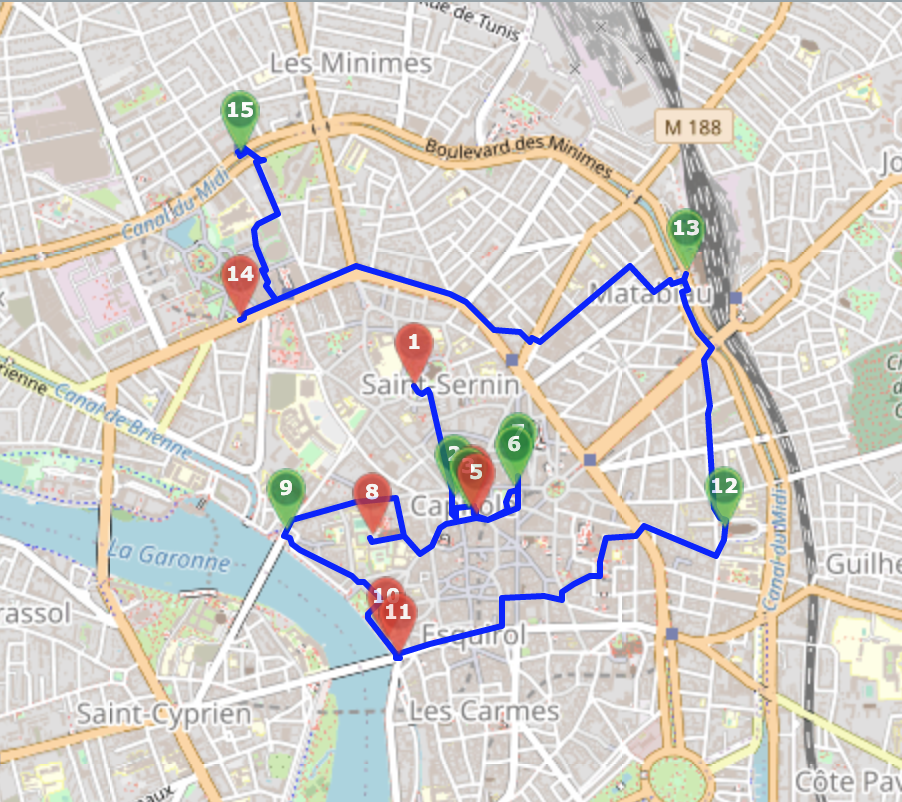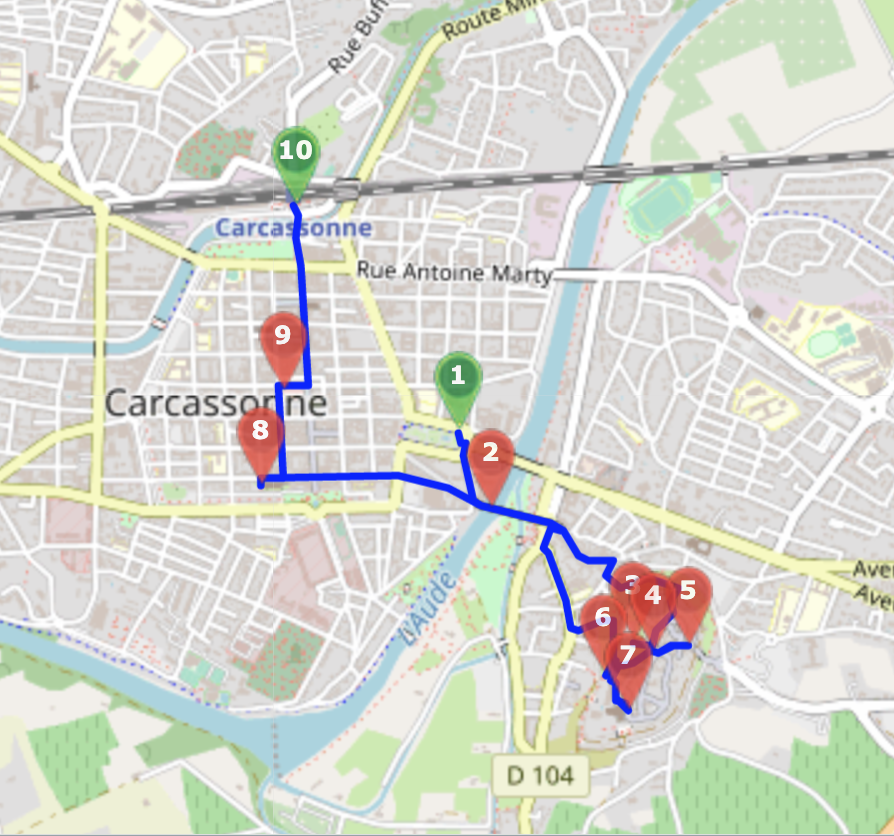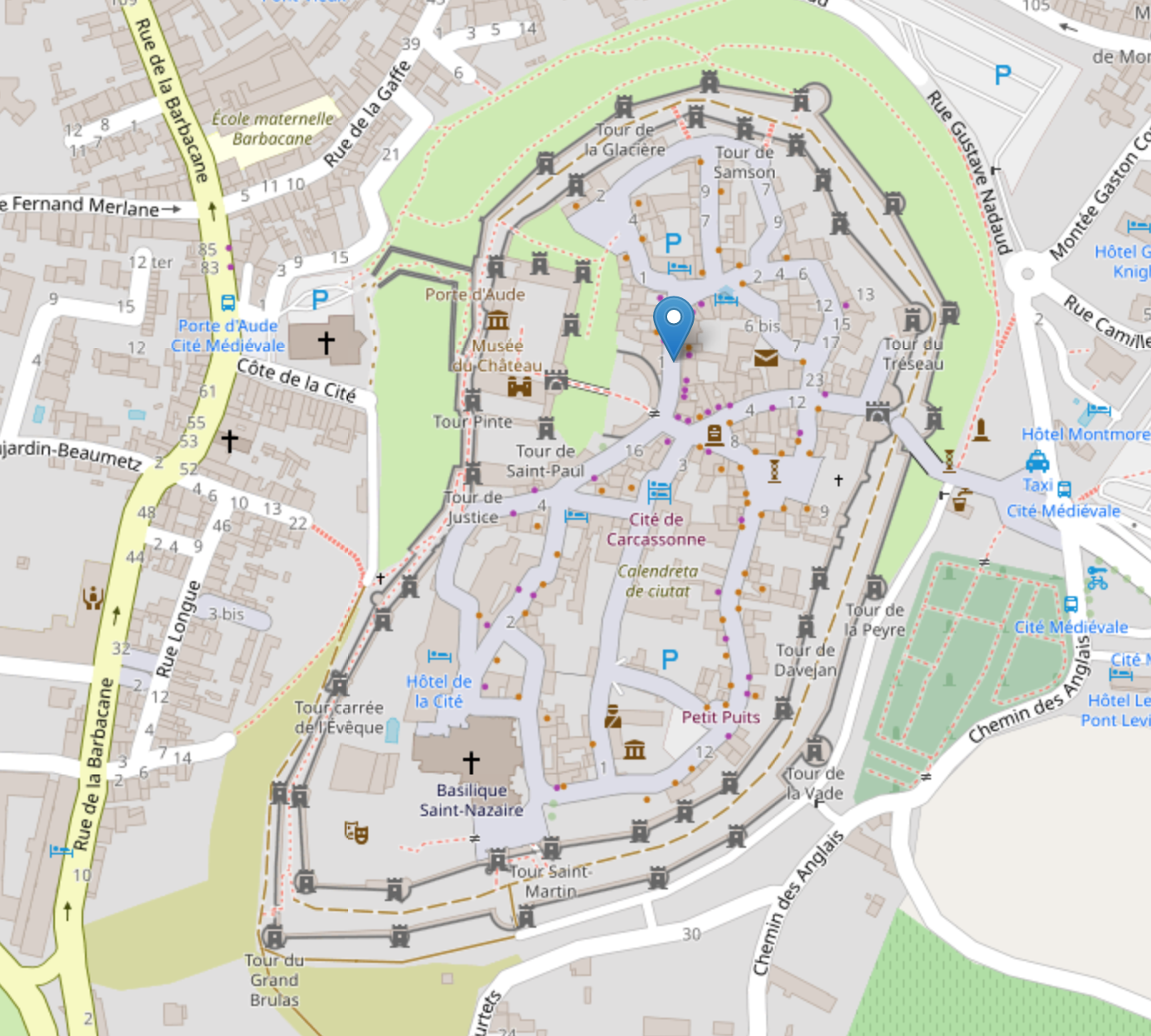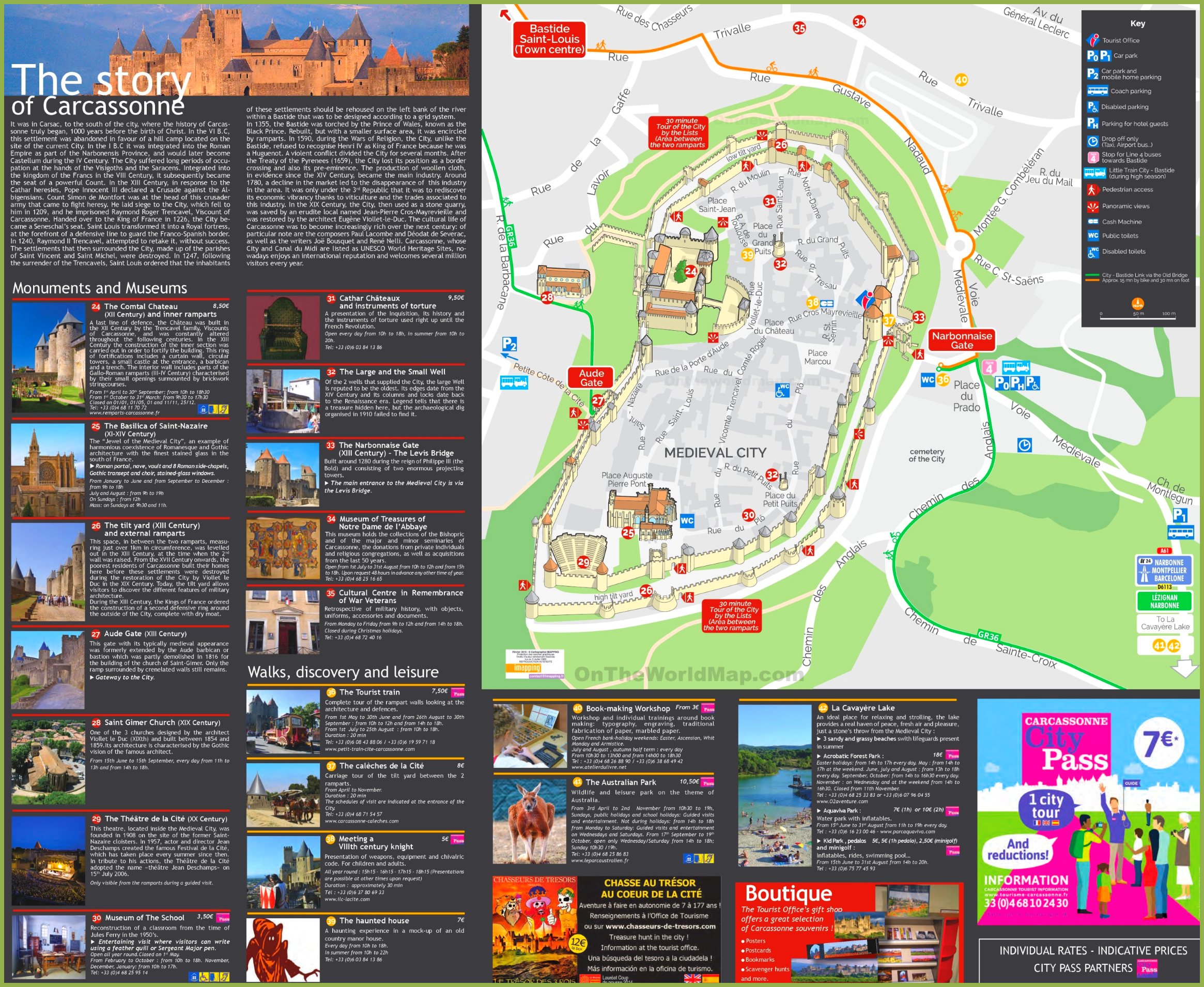France
1. Toulouse (La Ville Rose)

-
In its history, Toulouse has seen many Spanish coming to the city to flee from the civil war, which makes it the most Spanish city in France.
1.1. Top sights
1.1.1. Basilique Saint-Sernin (Basilica of Saint Sernin)
- It is the largest remaining Romanesque building in Europe.
- It is located on the site of a previous basilica of the 4th century.
- It is constructed between about 1080 and 1120.
- In 1998, UNESCO inscribed it as a World Heritage Site.
1.1.2. Capitole Market
- It is held every Wednesday in the Capitole.
1.1.3. Place du Capitole (Capitol Square)
- It is a square with a big pink brick building built in 1189 and completed with a neo-classical facade in 1760.
1.1.4. Le Capitole (Capitole de Toulouse)
- Le Capitole is home to city hall, the Theatre du Capitole de Toulouse opera company and the Orchestre National du Capitole de Toulouse.
1.1.5. Theatre du Capitole (Capitol Theatre)
- The first performance space in the building was created in 1736 by Guillaume Cammas.
1.1.6. Square Charles de Gaulle (Charles-de-Gaulle Square)
- It is located in back of the Le Capitole.
1.1.7. Rue d’Alsace Lorraine (Alsace-Lorraine Street)
- It’s an avenue of dark stone, shrubs, street lights, and a huge sidewalk for pedestrians.
1.1.8. Le couvent des Jacobins (Church of the Jacobins)
- It is in the center of town.
1.1.9. Pont Saint-Pierre (Bridge Saint-Pierre)
- It crosses the Garonne River and connects Place Saint-Pierre and the hospital of La Grave.
1.1.10. Quai de la Daurade (La daurade Quay)
- It is a pleasent walkway along the Garonne river bank embankment.
- Recommended sightseeing time is 1-2 hours.
1.1.11. Pont Neuf (New Bridge) (Grand Pont)
- It is a 16th-century asymmetrical bridge.
- It is the oldest bridge in Toulouse which links Gascogne to the Languedoc.
- It strectches across the Garonne River.
1.1.12. Église Saint-Aubin de Toulouse (Saint Aubin Church)
- It is one of the most atypical churches, with its massive appearance, combined with Gothic, Romanesque and Byzantine influences that stands out in the ecclesial landscape.
1.1.13. Gare de Toulouse Matabiau (Main Railway Station)
- The trains run to most parts of France.
1.1.14. Jardin Japonais (Japanese Garden)
- Jardin Japonais was created in 1981.
- It offers botanical varieties from the Far East.
1.1.15. Canal Du Midi
- The canal is considered one of the greatest construction works of the 17th century.
- Canal du Midi refers to the portion initially constructed from Toulouse to the Mediterranean.
- In 1996, UNESCO inscribed it as a World Heritage Site for its outstanding engineering and artistic design.
1.2. What and Where to eat
1.2.1. Marché Victor Hugo (Victor Hugo Market)
- Marché Victor Hugo is a 100-year-old covered market.
- Here you’ll find the best-quality local products. Fish, delicatessen, fruit and vegetables, bakery, and pastry are located in the market.
1.2.2. Pâtisserie Conté - Le Fénétra (Fenetra Cake)
- A tasty traditional Toulousian cake containing almond meringue, apricot jam and candied lemon.
- The dessert has been a part of the city’s heritage dating back to Roman antiquity.
- Specialties of Conté: Chocolate Pie, Raspberry Pie, Blueberry Pie, Lemon Meringue Pie, Pear-Chocolate, Tart Apple Pie, Apple Pie, Chocolate Pie, Capitol, Raspberry Tart, Pecan Praline, Citrus Crispy, Chocolate, Black Forest, Carrack, Strawberry Tart, Well of Love, Crunchy Hazelnut and Dacquoise
1.2.3. Criollo Chocolatier - Chocolate
1.2.4. Antoine Fornara Patisserie - Viennoiseries and Chocolate
1.2.5. La Maison de la Violette - Violettes de Toulouse
- One of the city’s most recognizable symbols, violets have been cultivated in Toulouse since the mid-19th century.
- Legend has it that it was a soldier in Napoleon III’s army who first introduced violets to Toulouse; he had collected them as a gift for his lover while stationed in Italy.
1.2.6. Maison Pillon - Brique du Capitole (Brick-shaped bonbons)
- The history of Brique du Capitole started in 1951 when the Nougalet chocolate and confectionery factory created lovely praline brick-shaped candies.
1.2.7. Boulangerie Cyprien - Viennoiseries
- Croustade aux pommes (Crispy apple pie)
- Specialties of Cyprien: Bread, Bread roll, Flatbreads, Bagels, Pastries, Buns, Cakes, Pies, Tarts and Croissants
1.2.8. Au Poussin Bleu - Viennoiseries
- Specialities of Au Poussin Bleu: Fruites, Macrons, Cupcakes, Classiques, Chocolates, Fruit Pastes, Bread, Bread Roll, Flatbreads, Bagels, Pastries, Buns, Pies, Tarts and Croissants
1.2.9. Xavier - Cabécou
- A soft creamy goat cheese
1.2.10. Croquants
- This savoury dessert consists of crisp biscuits made from almonds and caramelised sugar.
- It is the perfect way to finish off a traditional Toulouse meal.
2. Carcassonne

-
You can tour all districts of Carcassonne by walking or cycling.
2.1. Top sights
2.1.1. Place Gambetta (Gambetta Square)
- It is an open space with two rows of trees, garden beds, plenty of seating, and food kiosks.
- 10 minutes is enough for a quick walk through the park.
2.1.2. Le Pont Vieux (Old Bridge)
- It was reconstructed in the 14th century.
- It links the two cities of Carcassonne together.
- It is the best place to get wonderful views of the city.
2.1.3. Chateau et Remparts (Castle and Ramparts)
- A ticket is required.
- Openning hours
- It’s just a 10-min walk, crossing the river Aude on the Pont-Vieux bridge.
2.1.3.1. The château Comtal

- A one-hour visit with a guide will allow you to understand one thousand years of history in the Cité, its interior and exterior defence system, and the 19th century restoration by Viollet-le-Duc.
- You will admire its Romanesque frescoes, its Roman, Romanesque and Gothic architectural treasures, Lady Carcas, and the city’s archaeological collections.
- Chateau was defended by two barbicans:one to the east, which is now the entrance and ticket office, and the other to the west, towards the Aude, now partially in ruin.
- The exceptional view and photo opportunity of the château, from place Saint-Jean, a restaurant terrace or the small square on la rue de la porte d’Aude.
2.1.3.2. The Northern Gallo-Roman rampart
- A 20-min visit is enough.
- Its superbly preserved ancient round towers, stunning panoramic views across the Montagne Noire, and 1,000 years of military architecture.
- Exit at Porte Narbonnaise.
2.1.3.3. The western medieval rampart
- A 30-min visit is enough.
- In the 13th century, Saint-Louis and his successors had a second wall built, with round, often low towers with no roof.
- The bishop’s square tower, the Cathars and the inquisition tower, Viollet-le-Duc’s restoration work, spectacular views across the city, the basilica of Saint-Nazaire, the theatre and the Pyrenees.
- Exit at the Saint-Nazaire tower.
2.1.4. Cité de Carcassonne (Fortified City of Carcassonne)

- It tooks approximately 3 hours.
- In 1997, UNESCO inscribed it as a World Heritage Site because it is an excellent example of a medieval fortified town whose massive defences were constructed on walls dating from Late Antiquity.
- Since the pre-Roman period, a fortified settlement has existed above the Aude plain.
- The city’s three kilometres of ramparts, two fortresses, four gates, 52 towers and arrow slits offer remarkable views of the surrounding area.
2.1.5. Porte Narbonnaise (Narbonnaise Gate)
- It is the main gate to the city.
- You can access Carcassonne through this gate.
- It was built during the reign of Phillipe III about 1280.
2.1.6. Porte de l’Aude (Aude Gate)
- It is one of the entrances to the fortress.
- Very picturesque course and magnificent view of the ramparts
2.1.7. Basilique Saint-Nazaire (Basilica of Saint-Nazaire)
- The “Jewel of the City” (11th-14th centuries)
- Saint Nazaire is an example of the harmonious coexistence between the Romanesque and Gothic, and whose stained glass windows are the most beautiful in the Midi region.
- The Visigoths built the original church on this site in the 6th century.
- Current was completed in the 12th century.
- The Gothic interior architecture and decorations include alternating round and square support pillars, the Saint-Pierre Vault, additional vaults with a Scandinavian influence, and the tomb of Bishop Radulphe.
2.1.8. Cathédrale Saint-Michel de Carcassonne (Carcassonne Cathedral)
- This Gothic cathedral dates from the 13th century.
- It was classified as a national monument.
2.1.9. Place Carnot (Carnot Square)
- 5 minutes is enough for a quick walk through the square.
- It is the central square of the lower town of Carcassonne.
- There is the fountain La Fontaine de Neptune in the middle of the square.
2.1.10. Gare de Carcassonne (Carcassonne Station)
- It was built in 1857.
- The fortified city is around a 30-45 minute walk, mostly uphill.
2.2. Eat & Drink
3. Bordeaux

- The Celtic tribe that gave Bordeaux the name Burdigala, meaning swamp shelter, in the Basque language in reference to the area’s marsh environment.
- UNESCO inscribed the Port of the Moon, a port city of Bordeaux in south-west France, as an inhabited historic city, an outstanding urban and architectural ensemble, created in the age of the Enlightenment, whose values continued up to the first half of the 20th century.
- It has more protected buildings than any other French city except Paris.
3.1. Top sights
3.1.1. Grand Théâtre de Bordeaux (Grand Theatre)
- It is an opera house inaugurated in 1780.
- It was designed by the architect Victor Louis, one of the most active of late 18th-century French Neoclassical architects.
- It was conceived as a temple of the Arts and Light, with a neo-classical facade.
- It has a portico of 12 Corinthian-style colossal columns which support an entablature on which stand 12 statues. The statues represent the nine Muses and three goddesses, Minerva, Venus and Juno.
3.1.2. Église Notre-Dame (Church of Our Lady)
- It is the most baroque and Romanesque-style church in Bordeaux.
- The funeral of romantic Spanish painter Francisco Goya took place in this magnificent French Baroque church in 1828.
- Its acoustics are exceptional, so catching a free organ concert is well worth it.
3.1.3. Monument aux Girondins
- Monument aux Girondins is one of the most photographed spots in Bordeaux.
- The Girondists fell victim to the Reign of Terror during the French Revolution. In memory of them, this 54-meter-tall monument was erected by Henri-Louis Duhamel du Monceau in 1829. Duhamel is used to indicate this person as the author when citing a botanical name.
- It is located in Place des Quinconces, which is among the largest city squares in Europe.
- Among the sculptures are:
- towards the large theatre: triumph of the Republic
- towards Chartrons: triumph of the Concorde
- towards the river: the Tribune with the French cockerel; to its right, History, and on its left, the Éloquence (2 seated people).
- towards the Tourny square: the city of Bordeaux sitting on the prow of a ship with a cornucopia. To the right of the base: the river Dordogne and to the left the Garonne.
3.1.4. Quinconces Esplanade (Esplanade des Quinconces) (Quinconces Square)
- It is one of the largest and most-photographed sites in the city.
- It is the most emblematic of the French Revolution in Bordeaux with the famous monument built for the Girondins.
- It also contains huge statues of Montesquieu and Michel de Montaigne.
- It is the venue all year for fairs, circuses, and sporting and artistic events.
3.1.5. Jardin Public (Public Garden)
- It has been dear to the hearts of the Bordelais since its creation in 1746.
- It was designed with its 18th-century adaptations to emulate the great English parks in places like London.
3.1.6. La Place de la Bourse Illuminée (Stock Exchange Square)
- It is Bordeaux’s most iconic square.
- It is one of the most representative works of classical French architectural art of the 18th century.
- In 2007, UNESCO inscribed La Place de la Bourse Illuminée on World Heritage List as “an outstanding urban and architectural ensemble” of the 18th century.
3.1.7. Miroir d’Eau (Water Mirror)
- It is the largest water mirror in the world.
- It covers an area of 3450 sq metres of black granite on the quayside opposite the imposing Palais de la Bourse.
- Every 23 minutes a dense fog-like vapour is ejected for three minutes to add to the fun and photo opportunities.
3.1.8. Place du Parlement (Parliament Square)
- Italian-style square in the Saint-Pierre district, in the historic heart of Bordeaux and a stone’s throw from Place de la Bourse, Place du Parlement enjoys a central location in the city.
- It is lined with splendid facades that date from the first half of the 18th century.
3.1.9. Porte Cailhau (Palace Gate)
- It remains unchanged although it is built in 1495.
- It was dedicated to King Charles VII after his victory at the Battle of Fornovo (Italy).
3.1.10. Grosse Cloche (Big Bell)
- It was built in the 15th century.
- It is one of the two middle-aged entrances to the city.
- It also served as a defensive fort along city walls and as a prison.
3.1.11. Cathedrale Saint-Andre (Cathedral of St Andrew) (Bordeaux Cathedral)
- This gothic cathedral was built between 12th and 16th centuries.
- It celebrated two royal weddings: Eleanor of Aquitaine and the future Louis VII of France, and Anne of Austria and Louis XIII.
3.1.12. Hôtel de ville de Bordeaux (Palais Rohan) (City Hall)
- It is Bordeaux’s City Hall building.
- It is completed in 1784.
- The palace interior contains many typical elaborate Bordelais styles of the era, like sculpted woodwork, trompe d’oeil paintings by Lacour, and a grand central staircase.
- The interior can be viewed on a French-language guided tour each Wednesday, organized by the Bordeaux Tourist Office.
3.1.13. Basilique Saint-Michel (Basilica of St. Michael)
- This Flamboyant Gothic church was built at the turn of the 15th century.
- There is a market under the beautiful spire every Monday and Saturday morning.
3.1.14. Pont Jacques Chaban Delmas (Jacques Chaban-Delmas Bridge)
- It was inaugurated on 16 March 2013.
- It is a vertical-lift bridge over the Garonne River.
- It is the longest vertical-lift bridge in Europe.
- When night falls, the bridge is illuminated and constitutes yet another beautiful facet of the Port of the Moon, to the delight of Bordelais and photographers.
3.1.15. La Cite du Vin (City of Wine Museum)
- It tooks between 2 and 3 hours.
- La Cite du Vin is a unique cultural centre dedicated to the universal, living heritage of wine.
3.1.16. Tour Pey Berland (Pey-Berland Tower)
- It is the separate bell tower of the Bordeaux Cathedral.
- It allows the best view of the city.
- This 15th-century Gothic bell tower was named after Archbishop Pey Berland, who initiated its construction in 1440.
3.1.17. Place Fernand-Lafargue
- It is home to lively café terraces and hosts many small street concerts.
- Former Place du Vieux Marché was the scene of other tortures inflicted by the executioner under the orders of the Jurade in the Middle Ages and until the 17th century.
- It was also that of the meat and fish trade, market gardening products and bread.
3.1.18. Église Saint-Pierre (St. Peter Church)
- It is a Medieval church with flamboyant Gothic architecture.
3.1.19. Maison Gobineau
- The triangular-shaped building at the southern tip of Allées de Tourny looks like New York’s famous Flatiron Building.
3.1.20. Rue Saint Catherine
- Nestled in the heart of Bordeaux, stretching between Place de la Comédie and Place de la Victoire, it is the longest shopping street in Europe.
3.1.21. Porte Dijeaux
- It is an 18th century construction in the neoclassical style.
3.1.22. Pont de Pierre (Stone Bridge)
- This first bridge over the river Garonne at Bordeaux was planned and designed during the First French Empire, under the orders of Napoleon I.
3.2. Eat & Drink
3.2.1. Puits d’amour (Wells of love)
- A small cupcake topped with cream and caramel.
- It appeared in French chef Vincent De La Chappelle’s 1735 book Le cuisinier moderne.
3.2.2. Dunes Blanches chez Pascal Bordeaux
- A protected trademark
- Little round chouquettes pastries topped with a mixture of cream and whipped cream.
3.2.3. Cepes de Bordeaux (Porcini mushrooms)
4. Paris
4.1. Top sights
- Arc de Triomphe
- Auvers-sur-Oise (Van Gogh)
- Bois de Boulogne
- Château de Versailles (Palace of Versailles)
- Cathédrale Notre-Dame de Paris
- Jardin des Plantes
- Musée du Louvre (Louvre Museum)
- Musée Marmottan Monet
- Musée Rodin (Rodin Museum)
- Palais Garnier
- Panthéon
- Place de la Bastille
- Place de la Concorde
- Sacré-Cœur
- Sainte-Chapelle
- Tour Eiffel (Eiffel Tower)
- Versailles
- Vincennes Woods (Bois de Vincennes)